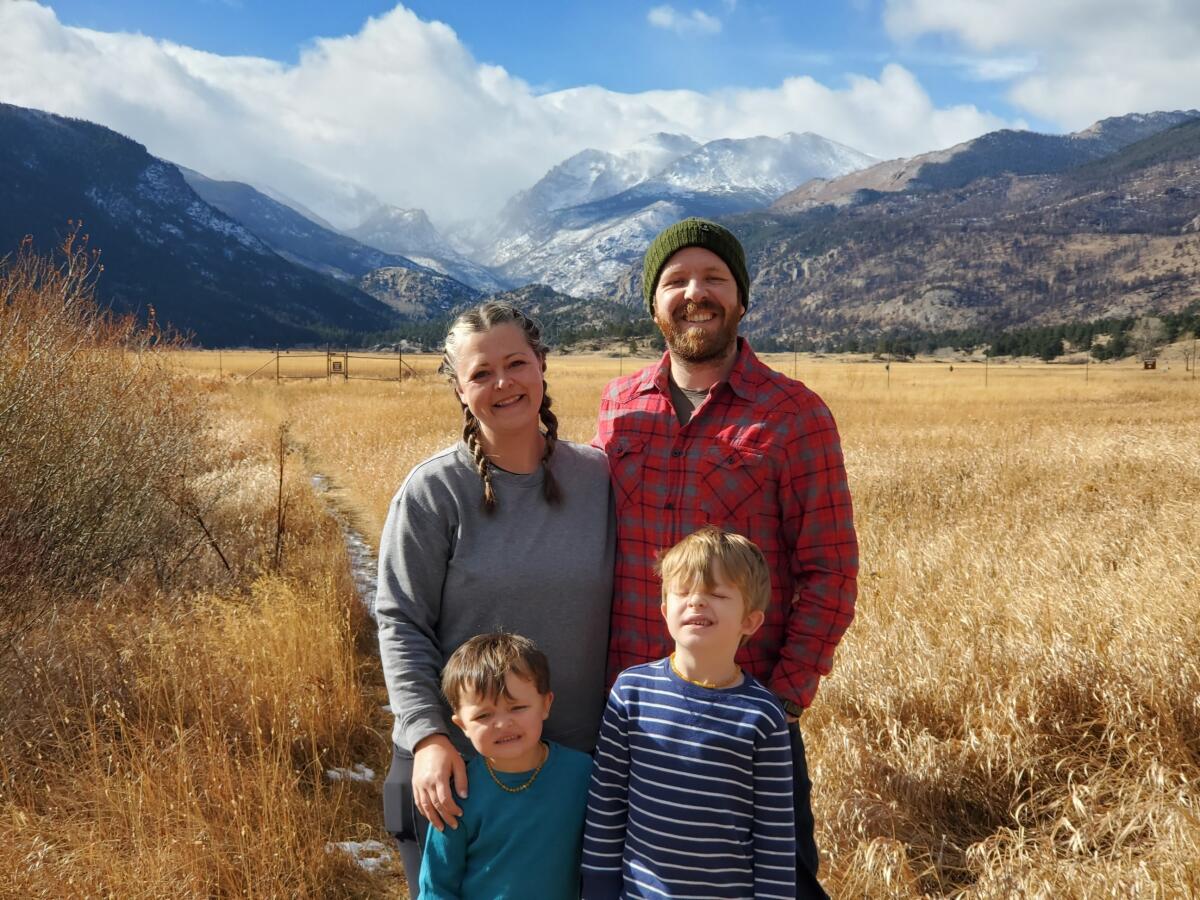San Diego County loses population for first time in a decade

- Share via
SAN DIEGO — Cody Barbo never thought he would want to leave San Diego.
But a couple of months ago, the co-founder and CEO of venture-backed startup Trust & Will relocated with his family to Dallas — a move driven by his ability to work remotely and disillusionment after attempting to purchase a house in San Diego.
This story is for subscribers
We offer subscribers exclusive access to our best journalism.
Thank you for your support.
“It wasn’t the cost. We could afford a nice house. It was the competitiveness of being able to buy a home,” said Barbo. “We were seeing 20 to 30 offers on some homes. They were all-cash offers, oftentimes 10% to 15% above list price. You just can’t compete with that.”
Barbo isn’t alone in thinking the grass may be greener outside of California these days. U.S. Census Bureau data released last month showed San Diego County’s population fell by 11,183 residents from July 2020 to July 2021 — mirroring the wider trend of more people leaving California’s high-priced coastal urban centers.
The data raise questions about whether the state’s expensive metro areas are on the brink of population declines fueled by falling birth rates, lower levels of foreign immigration and more residents fleeing for lower-cost locales.
These demographic shifts over time could reshape such things as workforce availability, school funding and job opportunities.
“What this means is that economic development from here on out is really all about labor force expansion,” said Christopher Thornberg, founding partner of Beacon Economics in Los Angeles. “And one thing that California is bad at is labor force growth because we just won’t build enough housing. And that has been true for over two decades now.”
To be clear, San Diego is not the epicenter of California’s exodus, which recently caused the state to lose a congressional seat for the first time in its history.
San Diego County’s net population loss was well under 1% — 0.3% to be exact — of its 3.28 million residents.
In comparison, Los Angeles County lost nearly 160,000 people, a 1.6% decline. San Francisco shed 55,800 people, or 6.3%. Santa Clara County, which encompasses Silicon Valley, lost 45,000 people, or 2.3%.
Still, this is the first time in at least a decade that San Diego County has lost population year over year, according to California Department of Finance data.
Meanwhile, Riverside and San Bernardino counties gained residents as more folks moved from dense cities to avoid the risk of exposure to COVID-19. Riverside County alone added 35,600 residents.
“Riverside and San Bernardino are growing because people are fleeing L.A.,” said Dowell Myers, a professor of policy, planning and demography at USC. “People are moving out of dense areas. They are moving outward to safer areas, and they’re moving to more affordable housing.”
After renting a townhouse in Point Loma for six years, Barbo, 33, began looking to buy a house in the neighborhood. His family was growing with a 2-year-old daughter. Both he and his wife work full time and believed they could find something.
The competition was intense. Barbo scanned Zillow daily, watching prices soar. At the same time, a few friends and colleagues were moving to other states — particularly low-tax states.
“We started doing the math in California,” said Barbo. “It’s not just the mortgage. We have child-care costs, all these added costs. It is a very expensive place, long-term, to live.”
They widened their search to include Las Vegas, Salt Lake City, Nashville and a few cities in Texas. Dallas rose to the top. They purchased a new, 4,300-square-foot home with a backyard big enough for a playground set and trampoline for their daughter.
“Within 30 minutes of the Dallas area, you can get a brand-new home — there is so much construction out here — for under $1 million,” said Barbo. “It is a nice, safe community. Good schools. Lots of activities. And people go out of their way to be kind. It’s noticeable.”
The location is near Dallas Love Field, which offers daily flights to San Diego. “I expect to fly back pretty often,” said Barbo, who sought support from Trust & Will’s board of directors before making the move.

The fintech startup, which automates estate planning, remains committed to keeping its headquarters in San Diego, added Barbo. The company grew more comfortable hiring remote employees during the pandemic and now has workers in 20 states.
California lost about 262,000 residents between July 2020 and July 2021, according to the Census Bureau. Of the 10 counties nationwide with the largest population losses, four were in California. New York also had four counties on the list.
U.S. metropolitan statistical areas, which can include multiple counties, that gained the most population last year were Dallas-Fort Worth, Phoenix-Mesa, Greater Houston, Austin-Round Rock and Riverside-San Bernardino, according to Census Bureau data.
Nathan Resnick, chief executive of Sourcify, moved from San Diego to Salt Lake City and bought a house there in July 2020.
The company, which helps clients with overseas manufacturing, has had a mostly remote workforce since it was founded in 2017. When the pandemic hit and California rolled out restrictions, Resnick said he found living in San Diego less appealing.
“It was everything, from shutting down the beaches to all the mandates,” he said. “And, too, the taxes sort of played a role — the business environment. Utah is really a pro-business state and very well run. We saw tremendous growth doing business from Utah and Salt Lake through the pandemic.”
Sourcify has one worker remaining in San Diego, down from about 10 at its peak, said Resnick.
Three components — births versus deaths; foreign immigration; and domestic move-ins versus move-outs — make up county-level population data. San Diego County had roughly 10,600 more births than deaths last year, according to the Census Bureau. Foreign immigration was slightly positive, but not as much as in past years.
Those gains weren’t enough to offset the net loss of 22,800 residents who moved away, according to Census Bureau data.
“I think part of that has to do with the pandemic and the ability to telecommute,” said Ray Major, chief economist at the San Diego Assn. of Governments. “But a lot of it has to do with the cost of living here. We have high state taxes. We have some of the highest housing costs. We have the highest electricity rates in the nation. We have the highest gasoline costs. Those types of things make people rethink where they want to live.”
Of all the factors driving people to move, the lack of housing looms the largest, said Major.
“We’re short about 200,000 units,” he said, “and we’re building 7,000 to 7,200 units a year. I don’t even know how many years it would take to build ourselves out of this. But we’re certainly not building enough housing right now to keep up with demand.”
Brigid McMillan moved from San Diego to Colorado in 2019. Both she and her husband were in the military and went to San Diego State University following their service.
“We graduated from college. We had our first couple of kids, and we had been looking at buying a house for a long time,” she said. “And it never seemed like the right time. We were like, it’s too expensive right now. We’ll wait for it to get a little better. It never did.”

McMillan had family in the Denver area that had invested in real estate. They had a house available. Her husband was able to work remotely at least part of the time. So the family decided to relocate.
“At that point, we had been married for 10 years, and we had roommates for eight of those years,” she said. “We had spent a long time living as economically as we could. We were ready to let our money go a little further.”
Denver, however, also has seen home values skyrocket, with annual price gains of 22.3%, according to the latest Case-Shiller home price index. In a couple of years, her relatives may sell the home she and her family are renting. When that happens, she’s not sure if they’ll try to buy or not.
“We’re kind of professional renters at this point,” she said. “There is a little bit of an appeal to it. But I think we’re in a waiting game.”
Demographers say 2021 population trends were influenced by COVID-19. One example is immigration. Ten years ago, San Diego County gained 11,065 people through foreign immigration, according to California Department of Finance data.
But foreign immigrants to San Diego County totaled fewer than 1,000 people from July 2020 to July 2021, according to Census Bureau data, as pandemic restrictions and tough border policies made it harder to enter the country.
San Diego County’s population decline came despite hiring in the region’s hot technology and biotech sectors.
Apple, Amazon and Google have expanded in the region, leasing large campuses. San Diego is home to the third-largest biotech cluster in the country, with Bristol Myers Squibb, Neurocrine and others expanding their footprints here recently. Local startups raised a record $9 billion in venture capital last year, which ranked behind only Silicon Valley, New York, Boston and Los Angeles.
People moving into the state are different than those leaving, according to the Public Policy Institute of California. Those moving here tend to be employed and earn higher incomes than those who move away. They are usually paid enough to afford expensive San Diego real estate.
That doesn’t bode well, however, for employers who can’t pay that much — some of whom could struggle to attract workers to move to the region for jobs given housing costs.
“Lord knows the military is having a tough time because they invite families here, and yet there’s very little market-rate housing that military people can afford,” said Thornberg of Beacon Economics. “So now the military has aggressive plans to build all sorts of their own housing because they can’t rely on the market to do it for them.”
Even so, Thornberg believes last year’s population losses in California are related to the pandemic and won’t last.
“I actually think it will stabilize in the next couple of years when the COVID data fades away,” he said. “Now I don’t expect migration to become strongly positive. There is just not enough housing. But I don’t expect it to continue to be negative, either. My guess is it will pan out at about zero, and you’ll see very small gains in population driven by natural increases” in births over deaths.
More to Read
Sign up for Essential California
The most important California stories and recommendations in your inbox every morning.
You may occasionally receive promotional content from the Los Angeles Times.











